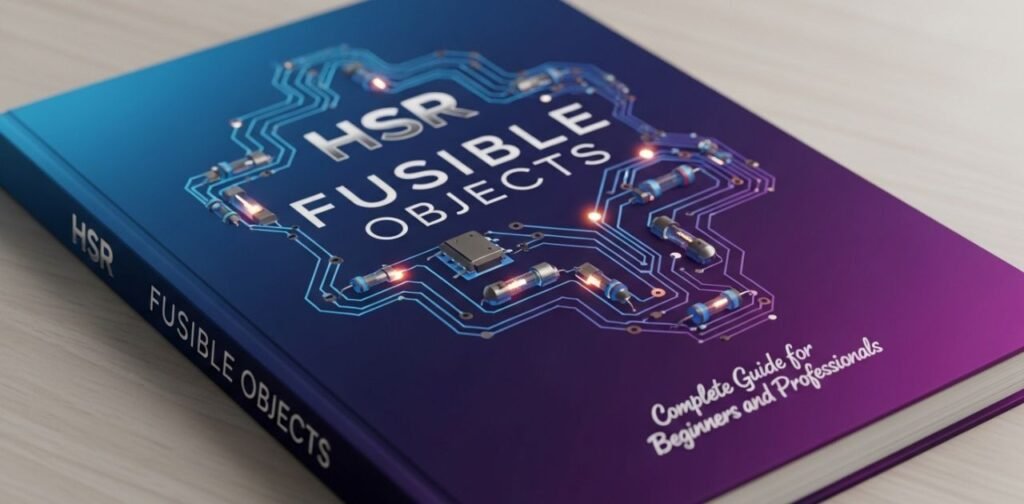Introduction to HSR Fusible Objects
In modern electrical engineering and circuit protection systems, HSR Fusible Objects play a crucial role. They are specialized components designed to ensure the safety, reliability, and efficiency of electrical systems. From industrial machines to household electronics, HSR Fusible Objects help prevent overcurrent damage, short circuits, and system failures by breaking the circuit when necessary.
The growing importance of HSR Fusible Objects comes from the increasing complexity of power systems. Today’s machines and networks require advanced protection mechanisms that not only guard against faults but also maintain system stability. HSR Fusible Objects are designed to fulfill these requirements.
This article will provide a complete overview of HSR Fusible Objects: what they are, how they work, their applications, benefits, and future prospects in the world of electrical and electronic engineering. Whether you are a student, engineer, or industry professional, this guide will give you a solid understanding of why HSR Fusible Objects matter in today’s technological landscape.
What Are HSR Fusible Objects?
HSR Fusible Objects are high-safety rated (HSR) components used in electrical circuits to protect against overcurrent and other fault conditions. Essentially, they function like traditional fuses but are engineered with more precision and reliability. The word “fusible” refers to their ability to melt or break under excessive current, thereby interrupting the flow of electricity and protecting the connected devices.
Unlike standard fuses, HSR Fusible Objects are designed for modern applications that require fast response times, consistent performance, and higher safety margins. These components are often used in sensitive equipment where even small power fluctuations can cause significant damage.
Key Characteristics of HSR Fusible Objects:
- High breaking capacity to handle sudden current surges
- Fast response times to protect delicate circuits
- Compact and durable designs suitable for different environments
- Compliance with international safety standards
In essence, HSR Fusible Objects are the modern evolution of traditional fuses. They bring advanced engineering into the picture, ensuring that industries and households alike have access to reliable circuit protection.
How Do HSR Fusible Objects Work?
Understanding the working principle of HSR Fusible Objects requires a closer look at the science of fuses. At their core, fusible objects rely on a metallic conductor designed to melt when current exceeds a specific threshold. When this happens, the circuit is interrupted, stopping the flow of electricity and preventing damage.
In the case of HSR Fusible Objects, this process is enhanced through advanced materials and design improvements. They are built to provide:
- Precision Control – The melting point is carefully engineered to ensure accuracy.
- High Reliability – Unlike cheaper fuses, they do not fail prematurely or inconsistently.
- Safety Features – Enclosures and insulating materials are used to prevent sparks or fire hazards.
- Durability – They can withstand environmental stresses such as heat, vibration, and humidity.
One of the standout features of HSR Fusible Objects is their ability to handle high surge currents without degrading performance. This makes them suitable for industries like power distribution, automotive electronics, and renewable energy systems.
Their functionality is simple yet effective: when the system runs normally, they allow current to pass. When the system exceeds safe limits, the fusible element reacts instantly, cutting off the circuit. This combination of simplicity and efficiency explains why HSR Fusible Objects are so widely adopted.
Applications of HSR Fusible Objects
HSR Fusible Objects are used across multiple industries due to their versatility and reliability. Here are the most common applications:
- Power Distribution Systems
Electrical grids and distribution networks use HSR Fusible Objects to protect transformers, substations, and transmission lines. - Industrial Equipment
Factories rely on heavy machinery, which requires protection from sudden current surges. HSR Fusible Objects ensure safety without disrupting production efficiency. - Automotive Sector
Modern vehicles, especially electric and hybrid cars, use HSR Fusible Objects to safeguard batteries, motors, and onboard electronics. - Renewable Energy
Solar panels, wind turbines, and other renewable energy setups need circuit protection against unpredictable fluctuations. HSR Fusible Objects provide stability to these systems. - Household Electronics
Appliances, air conditioners, and advanced home systems use HSR Fusible Objects for overcurrent protection. - Telecommunications and Data Centers
To ensure uptime and protect sensitive servers, HSR Fusible Objects are integrated into telecom and IT infrastructures.
The versatility of these fusible components makes them a universal choice wherever electrical safety is a priority.
Benefits of HSR Fusible Objects
Using HSR Fusible Objects comes with several benefits compared to standard fuses:
- Enhanced Safety: Engineered to meet strict safety requirements, they minimize risks of fire or electrical hazards.
- Cost Savings: By preventing major equipment damage, they reduce maintenance and replacement costs.
- Reliability: Unlike traditional fuses that may fail inconsistently, HSR Fusible Objects provide dependable performance.
- Compact Design: Their modern designs make them suitable for both large-scale industries and compact household devices.
- Adaptability: Applicable in multiple environments, from high-voltage grids to low-voltage electronics.
In a world where electrical systems are becoming more complex, these benefits make HSR Fusible Objects indispensable.
Future of HSR Fusible Objects
Looking forward, HSR Fusible Objects will become even more relevant as electrical systems evolve. With the rise of renewable energy, electric vehicles, and smart grids, the demand for advanced circuit protection is increasing. Future improvements may include:
- Smarter Materials: Self-healing or recyclable fusible materials to extend lifespan.
- Integration with IoT: Smart fusible objects that can send real-time data about system health.
- Higher Efficiency: Designs that reduce energy loss while improving safety.
- Eco-Friendly Manufacturing: Environmentally sustainable materials and processes.
These trends suggest that HSR Fusible Objects are not just a present necessity but also a future-proof solution in electrical engineering.
FAQs About HSR Fusible Objects
Q1: What does HSR in HSR Fusible Objects stand for?
HSR typically stands for High Safety Rated or High Surge Resistant, depending on the manufacturer’s specification.
Q2: How are HSR Fusible Objects different from normal fuses?
They are more reliable, faster in response, and built with higher safety standards compared to normal fuses.
Q3: Can HSR Fusible Objects be reused after blowing?
No, like traditional fuses, they need replacement after performing their protective function.
Q4: Where are HSR Fusible Objects most commonly used?
They are widely used in power distribution, industrial machinery, automotive systems, renewable energy, and household electronics.
Q5: Are HSR Fusible Objects expensive?
They may cost slightly more than regular fuses, but their reliability and safety make them cost-effective in the long run.
Conclusion
HSR Fusible Objects are at the heart of modern electrical safety. From protecting industrial machines to securing household devices, they ensure that systems remain stable, efficient, and safe. Their advanced design, reliability, and adaptability make them essential in today’s world of complex electrical networks.
As technology evolves, HSR Fusible Objects will continue to grow in importance, offering smarter, safer, and more sustainable solutions for industries and individuals alike.



